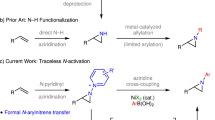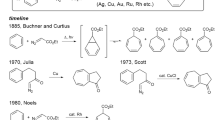Abstract
Aziridines—three-membered nitrogen-containing cyclic molecules—are important synthetic targets. Their substantial ring strain and resultant proclivity towards ring-opening reactions makes them versatile precursors of diverse amine products1,2,3, and, in some cases, the aziridine functional group itself imbues important biological (for example, anti-tumour) activity4,5,6. Transformation of ubiquitous alkenes into aziridines is an attractive synthetic strategy, but is typically accomplished using electrophilic nitrogen sources rather than widely available amine nucleophiles. Here we show that unactivated alkenes can be electrochemically transformed into a metastable, dicationic intermediate that undergoes aziridination with primary amines under basic conditions. This new approach expands the scope of readily accessible N-alkyl aziridine products relative to those obtained through existing state-of-the-art methods. A key strategic advantage of this approach is that oxidative alkene activation is decoupled from the aziridination step, enabling a wide range of commercially available but oxidatively sensitive7 amines to act as coupling partners for this strain-inducing transformation. More broadly, our work lays the foundations for a diverse array of difunctionalization reactions using this dication pool approach.
This is a preview of subscription content, access via your institution
Access options
Access Nature and 54 other Nature Portfolio journals
Get Nature+, our best-value online-access subscription
$29.99 / 30 days
cancel any time
Subscribe to this journal
Receive 51 print issues and online access
$199.00 per year
only $3.90 per issue
Buy this article
- Purchase on Springer Link
- Instant access to full article PDF
Prices may be subject to local taxes which are calculated during checkout




Similar content being viewed by others
Data availability
Crystallographic data for compounds 1 and 2 can be obtained free of charge from the Cambridge Crystallographic Data Centre (https://www.ccdc.cam.ac.uk). All data supporting the findings of this paper are available within the paper and its Supplementary Information.
References
Sweeney, J. B. Aziridines: epoxides’ ugly cousins? Chem. Soc. Rev. 31, 247–258 (2002).
Stanković, S. et al. Regioselectivity in the ring opening of non-activated aziridines. Chem. Soc. Rev. 41, 643–665 (2012).
Botuha, C., Chemla, F., Ferreira, F. & Pérez‐Luna, A. in Heterocycles in Natural Product Synthesis 1–39 (John Wiley, 2011).
Ismail, F. M. D., Levitsky, D. O. & Dembitsky, V. M. Aziridine alkaloids as potential therapeutic agents. Eur. J. Med. Chem. 44, 3373–3387 (2009).
Thibodeaux, C. J., Chang, W. & Liu, H. Enzymatic chemistry of cyclopropane, epoxide, and aziridine biosynthesis. Chem. Rev. 112, 1681–1709 (2012).
Lowden, P. A. S. in Aziridines and Epoxides in Organic Synthesis 399–442 (John Wiley, 2006).
Roth, H. G., Romero, N. A. & Nicewicz, D. A. Experimental and calculated electrochemical potentials of common organic molecules for applications to single-electron redox chemistry. Synlett 27, 714–723 (2016).
Evans, D. A., Faul, M. M. & Bilodeau, M. T. Copper-catalyzed aziridination of olefins by (N-(p-toluenesulfonyl)imino)phenyliodinane. J. Org. Chem. 56, 6744–6746 (1991).
Sweeney, J. B. in Aziridines and Epoxides in Organic Synthesis 117–144 (John Wiley, 2006).
Osborn, H. M. I. & Sweeney, J. The asymmetric synthesis of aziridines. Tetrahedron Asymmetry 8, 1693–1715 (1997).
Wang, H., Yang, J. C. & Buchwald, S. L. CuH-catalyzed regioselective intramolecular hydroamination for the synthesis of alkyl-substituted chiral aziridines. J. Am. Chem. Soc. 139, 8428–8431 (2017).
Legnani, L., Prina-Cerai, G., Delcaillau, T., Willems, S. & Morandi, B. Efficient access to unprotected primary amines by iron-catalyzed aminochlorination of alkenes. Science 362, 434–439 (2018).
Jat, J. L. et al. Direct stereospecific synthesis of unprotected N–H and N-Me aziridines from olefins. Science 343, 61–65 (2014).
Ma, Z., Zhou, Z. & Kürti, L. Direct and stereospecific synthesis of N–H and N-alkyl aziridines from unactivated olefins using hydroxylamine-O-sulfonic acids. Angew. Chem. Int. Edn 56, 9886–9890 (2017).
Cheng, Q.-Q. et al. Organocatalytic nitrogen transfer to unactivated olefins via transient oxaziridines. Nat. Catal. 3, 386–392 (2020).
Falk, E., Makai, S., Delcaillau, T., Gürtler, L. & Morandi, B. Design and scalable synthesis of N-alkylhydroxylamine reagents for the direct iron-catalyzed installation of medicinally relevant amines. Angew. Chem. Int. Edn 59, 21064–21071 (2020).
Munnuri, S., Anugu, R. R. & Falck, J. R. Cu(II)-mediated N–H and N-alkyl aryl amination and olefin aziridination. Org. Lett. 21, 1926–1929 (2019).
Govaerts, S. et al. Photoinduced olefin diamination with alkylamines. Angew. Chem. Int. Edn 59, 15021–15028 (2020).
eMolecules (eMolecules Inc, accessed 20 January 2021); https://www.emolecules.com
Lohray, B. B., Gao, Y. & Sharpless, K. B. One pot synthesis of homochiral aziridines and aminoalcohols from homochiral 1,2-cyclic sulfates. Tetrahedr. Lett. 30, 2623–2626 (1989).
Wenker, H. The preparation of ethylene imine from monoethanolamine. J. Am. Chem. Soc. 57, 2328 (1935).
Li, X., Chen, N. & Xu, J. An improved and mild Wenker synthesis of aziridines. Synthesis 20, 3423–3428 (2010).
Yan, M., Kawamata, Y. & Baran, P. S. Synthetic organic electrochemical methods since 2000: on the verge of a renaissance. Chem. Rev. 117, 13230–13319 (2017).
Wiebe, A. et al. Electrifying organic synthesis. Angew. Chem. Int. Edn 57, 5594–5619 (2018).
Francke, R. & Little, R. D. Redox catalysis in organic electrosynthesis: basic principles and recent developments. Chem. Soc. Rev. 43, 2492–2521 (2014).
Moeller, K. D. Using physical organic chemistry to shape the course of electrochemical reactions. Chem. Rev. 118, 4817–4833 (2018).
Yoshida, J., Kataoka, K., Horcajada, R. & Nagaki, A. Modern strategies in electroorganic synthesis. Chem. Rev. 108, 2265–2299 (2008).
Sauer, G. S. & Lin, S. An electrocatalytic approach to the radical difunctionalization of alkenes. ACS Catal. 8, 5175–5187 (2018).
Doobary, S., Sedikides, A. T., Caldora, H. P., Poole, D. L. & Lennox, A. J. J. Electrochemical vicinal difluorination of alkenes: scalable and amenable to electron-rich substrates. Angew. Chem. Int. Edn 59, 1155–1160 (2020).
Siu, T. & Yudin, A. K. Practical olefin aziridination with a broad substrate scope. J. Am. Chem. Soc. 124, 530–531 (2002).
Oseka, M. et al. Electrochemical aziridination of internal alkenes with primary amines. Chem 7, 255–266 (2021).
Chen, J. et al. Electrocatalytic aziridination of alkenes mediated by n-Bu4NI: a radical pathway. Org. Lett. 17, 986–989 (2015).
Li, J. et al. Electrochemical aziridination by alkene activation using a sulfamate as the nitrogen source. Angew. Chem. Int. Edn 57, 5695–5698 (2018).
Yoshida, J., Shimizu, A. & Hayashi, R. Electrogenerated cationic reactive intermediates: the pool method and further advances. Chem. Rev. 118, 4702–4730 (2018).
Hayashi, R., Shimizu, A. & Yoshida, J. The stabilized cation pool method: metal- and oxidant-free benzylic C–H/aromatic C–H cross-coupling. J. Am. Chem. Soc. 138, 8400–8403 (2016).
Shine, H. J., Bandlish, B. K., Mani, S. R. & Padilla, A. G. Ion radicals. 43. Addition of thianthrene and phenoxathiin cation radicals to alkenes and alkynes. J. Org. Chem. 44, 915–917 (1979).
Shine, H. J. et al. Adducts of phenoxathiin and thianthrene cation radicals with alkenes and cycloalkenes. J. Org. Chem. 68, 8910–8917 (2003).
Rangappa, P. & Shine, H. J. An overview of some reactions of thianthrene cation radical. Products and mechanisms of their formation. J. Sulfur Chem. 27, 617–664 (2006).
Berger, F. et al. Site-selective and versatile aromatic C−H functionalization by thianthrenation. Nature 567, 223–228 (2019).
Engl, P. S. et al. C–N cross-couplings for site-selective late-stage diversification via aryl sulfonium salts. J. Am. Chem. Soc. 141, 13346–13351 (2019).
Chen, J., Li, J., Plutschack, M. B., Berger, F. & Ritter, T. Regio- and stereoselective thianthrenation of olefins to access versatile alkenyl electrophiles. Angew. Chem. Int. Edn 59, 5616–5620 (2020).
Houmam, A., Shukla, D., Kraatz, H.-B. & Wayner, D. D. M. Electrosynthesis of mono- and bisthianthrenium salts. J. Org. Chem. 64, 3342–3345 (1999).
Iwai, K. & Shine, H. J. Ion radicals. 46. Reactions of the adducts of thianthrene and phenoxathiin cation radicals and cyclohexene with nucleophiles. J. Org. Chem. 46, 271–276 (1981).
Mitchell, S. C. & Waring, R. H. Fate of thianthrene in biological systems. Xenobiotica 47, 731–740 (2017).
Kaiser, D., Klose, I., Oost, R., Neuhaus, J. & Maulide, N. Bond-forming and -breaking reactions at sulfur(IV): sulfoxides, sulfonium salts, sulfur ylides, and sulfinate salts. Chem. Rev. 119, 8701–8780 (2019).
Bright, G. M., Brodney, M. A. & Wlodecki, B. Pyridyloxymethyl and benzisoxazole azabicyclic derivatives. International patent WO/2004/081007 (2004).
Qian, D.-Q., Shine, H. J., Guzman-Jimenez, I. Y., Thurston, J. H. & Whitmire, K. H. Mono- and bisadducts from the addition of thianthrene cation radical salts to cycloalkenes and alkenes. J. Org. Chem. 67, 4030–4039 (2002).
Speer, M. E. et al. Thianthrene-functionalized polynorbornenes as high-voltage materials for organic cathode-based dual-ion batteries. Chem. Commun. 51, 15261–15264 (2015).
Murata, Y. & Shine, H. J. Ion radicals. XVIII. Reactions of thianthrenium perchlorate and thianthrenium trichlorodiiodide. J. Org. Chem. 34, 3368–3372 (1969).
Sandford, C. et al. A synthetic chemist’s guide to electroanalytical tools for studying reaction mechanisms. Chem. Sci. 10, 6404–6422 (2019).
Acknowledgements
We thank A. Wendlandt, M. Levin and. D. Weix for suggestions and manuscript proofreading. We also acknowledge A. Hoque and F. Wang in the Stahl laboratory for the use of, and technical assistance with, the electrochemical flow reactor. Additionally, we thank the Weix, Stahl, Yoon and Schomaker groups for sharing their chemical inventories. B. J. Thompson is acknowledged for his assistance with the design and fabrication of the power supply. T. Drier is acknowledged for the fabrication of electrochemical glassware. A. M. Wheaton is acknowledged for assistance with crystallographic studies. We also acknowledge support and suggestions from all members of the Wickens group throughout the investigation of this project. This work was supported financially by the Office of the Vice Chancellor for Research and Graduate Education at the University of Wisconsin–Madison, with funding from the Wisconsin Alumni Research Foundation. Spectroscopic instrumentation was supported by a gift from P. J. and M. M. Bender, by National Science Foundation (NSF) grant CHE-1048642, and by National Institutes of Health (NIH) grants 1S10OD020022-1 and S10 OD01225. This study also made use of the National Magnetic Resonance Facility at Madison, which is supported by NIH grants P41GM136463 (old number P41GM103399 (NIGMS)) and P41RR002301. Equipment was purchased with funds from the University of Wisconsin–Madison, the NIH (grants P41GM103399, S10RR02781, S10RR08438, S10RR023438, S10RR025062 and S10RR029220), the NSF (DMB-8415048, OIA-9977486 and BIR-9214394), and the US Department of Agriculture (USDA). The Bruker D8 VENTURE Photon III X-ray diffractometer was partially funded by NSF award CHE-1919350 to the University of Wisconsin–Madison Department of Chemistry.
Author information
Authors and Affiliations
Contributions
Z.K.W., D.E.H. and D.J.W. designed the project. D.E.H., D.J.W. and M.J.K. performed the experiments and collected the data. I.A.G. collected and analysed X-ray data to provide crystal structures. Z.K.W., D.E.H., D.J.W. and M.J.K. analysed the data and contributed to writing the manuscript. D.E.H. and D.J.W. contributed equally.
Corresponding author
Ethics declarations
Competing interests
The authors declare no competing interests.
Additional information
Peer review information Nature thanks Louis-Charles Campeau and David Hickey for their contribution to the peer review of this work. Peer reviewer reports are available.
Publisher’s note Springer Nature remains neutral with regard to jurisdictional claims in published maps and institutional affiliations.
Supplementary information
Supplementary Information
The file contains the following sections: 1. General Methods and Materials; 2. Supplementary Data; 3. Mechanistic Investigations; 4. Substrate preparation; 5. General Experimental Procedures; 6. Aziridine Product Isolation and Characterization; 7. Scale-Up Flow Electrolysis Set-Up and Procedure; 8. Aziridine Derivatization Reaction Isolation and Characterization; 9. X-Ray Diffraction Data; 10. References; and 11. NMR Spectra.
Rights and permissions
About this article
Cite this article
Holst, D.E., Wang, D.J., Kim, M.J. et al. Aziridine synthesis by coupling amines and alkenes via an electrogenerated dication. Nature 596, 74–79 (2021). https://doi.org/10.1038/s41586-021-03717-7
Received:
Accepted:
Published:
Issue Date:
DOI: https://doi.org/10.1038/s41586-021-03717-7
This article is cited by
-
Unified metal-free intermolecular Heck-type sulfonylation, cyanation, amination, amidation of alkenes by thianthrenation
Nature Communications (2024)
-
N-Aminopyridinium reagents as traceless activating groups in the synthesis of N-Aryl aziridines
Nature Communications (2022)
-
Insertion of ammonia into alkenes to build aromatic N-heterocycles
Nature Communications (2022)
-
Radical ring formation
Nature Chemistry (2022)
-
Bringing amines back into aziridination
Nature Chemistry (2021)
Comments
By submitting a comment you agree to abide by our Terms and Community Guidelines. If you find something abusive or that does not comply with our terms or guidelines please flag it as inappropriate.



